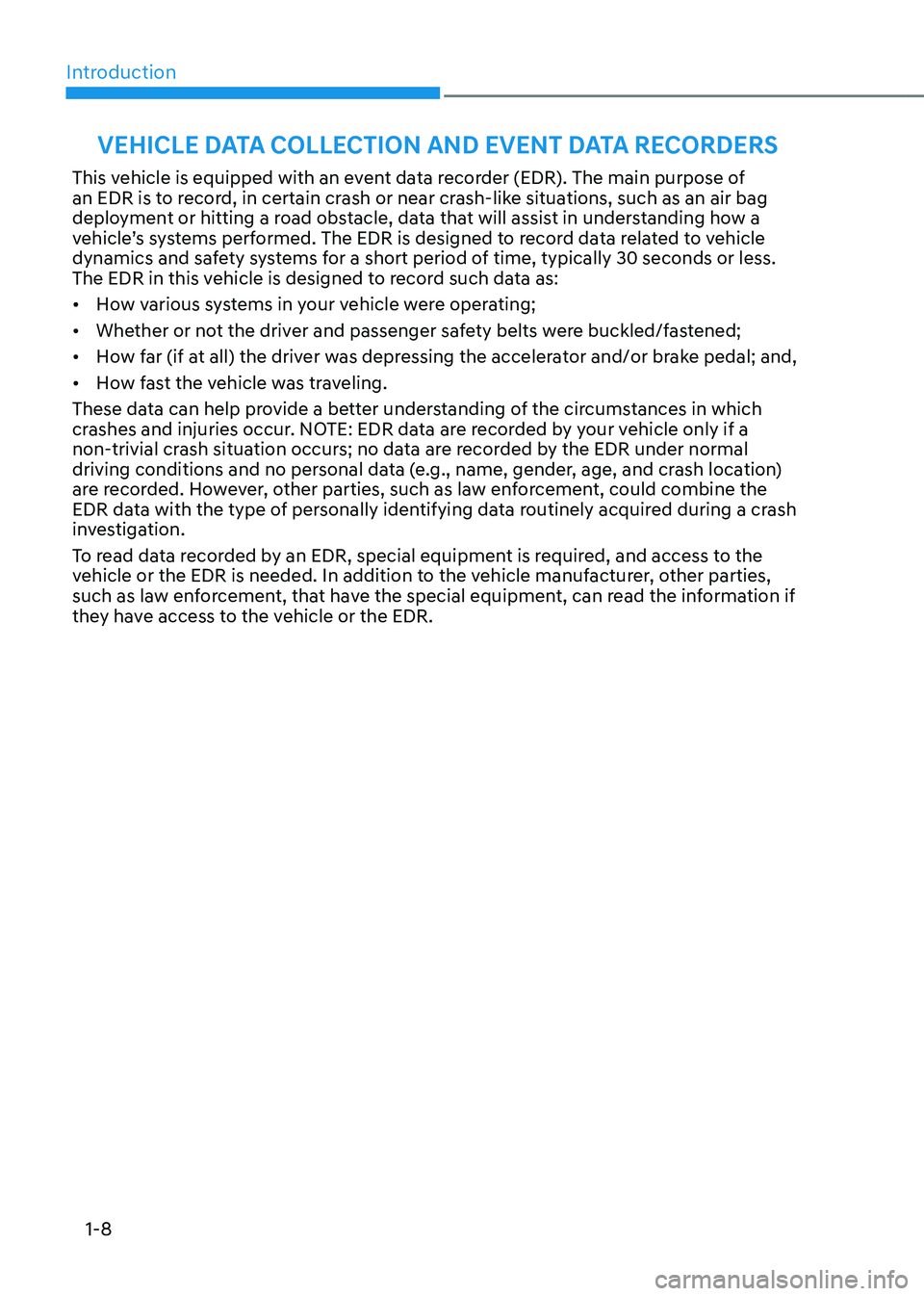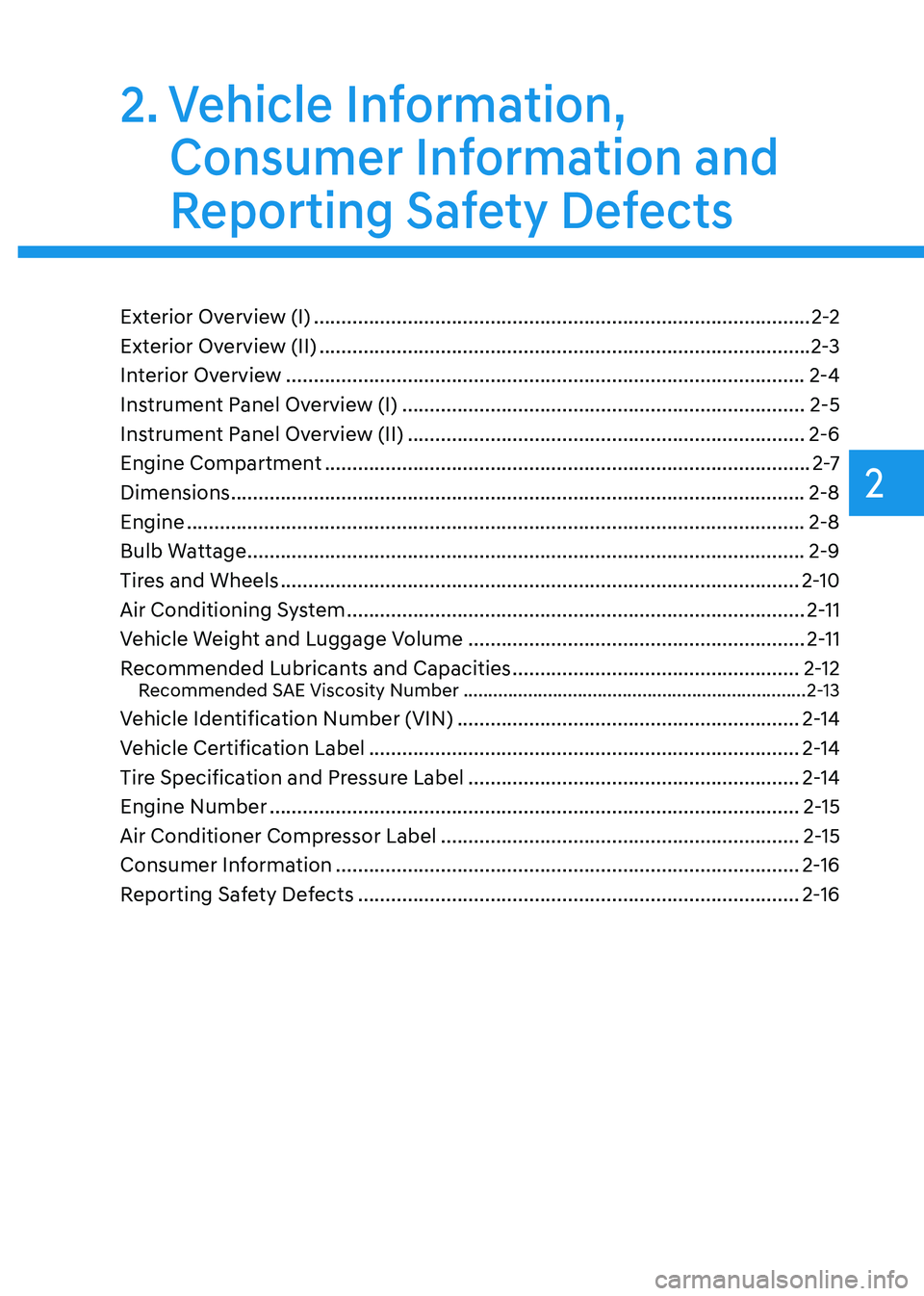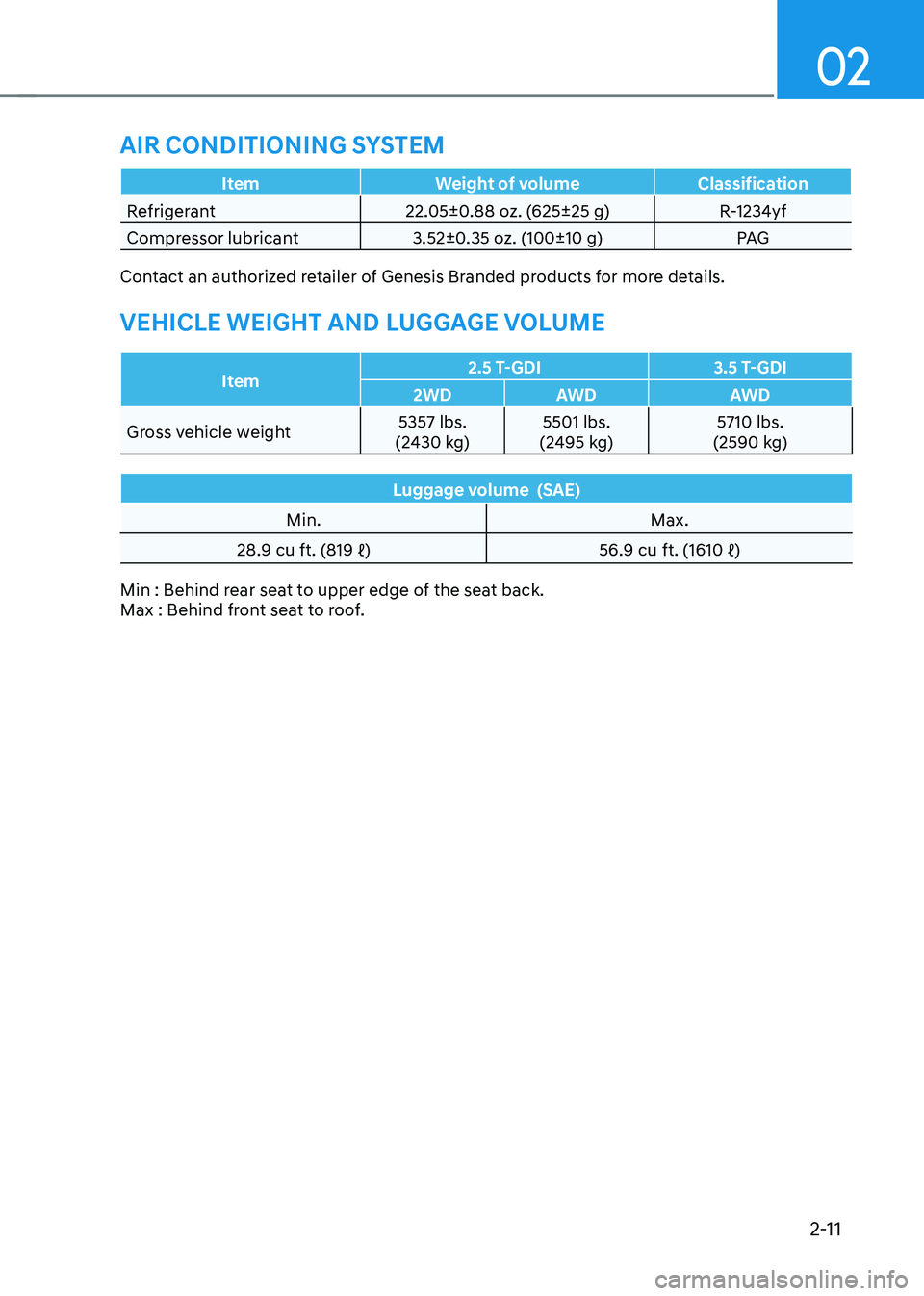2022 HYUNDAI GENESIS GV70 air condition
[x] Cancel search: air conditionPage 12 of 647

Introduction
1-8
VEHICLE DATA COLLECTION AND EVENT DATA RECORDERS
This vehicle is equipped with an event data recorder (EDR). The main purpose of an EDR is to record, in certain crash or near crash-like situations, such as an air bag deployment or hitting a road obstacle, data that will assist in understanding how a vehicle’s systems performed. The EDR is designed to record data related to vehicle dynamics and safety systems for a short period of time, typically 30 seconds or less.The EDR in this vehicle is designed to record such data as:
• How various systems in your vehicle were operating;
• Whether or not the driver and passenger safety belts were buckled/fastened;
• How far (if at all) the driver was depressing the accelerator and/or brake pedal; and,
• How fast the vehicle was traveling.
These data can help provide a better understanding of the circumstances in which crashes and injuries occur. NOTE: EDR data are recorded by your vehicle only if a non-trivial crash situation occurs; no data are recorded by the EDR under normal driving conditions and no personal data (e.g., name, gender, age, and crash location) are recorded. However, other parties, such as law enforcement, could combine the EDR data with the type of personally identifying data routinely acquired during a crash investigation.
To read data recorded by an EDR, special equipment is required, and access to the vehicle or the EDR is needed. In addition to the vehicle manufacturer, other parties, such as law enforcement, that have the special equipment, can read the information if they have access to the vehicle or the EDR.
Page 13 of 647

2. Vehicle Information,
Consumer Information and
Reporting Safety Defects
Exterior Overview (I) ........................................................................\
..................2-2
Exterior Overview (II) ........................................................................\
.................2-3
Interior Overview ........................................................................\
......................2-4
Instrument Panel Overview (I) ........................................................................\
.2-5
Instrument Panel Overview (II) ........................................................................\
2-6
Engine Compartment ........................................................................\
................2-7
Dimensions ........................................................................\
................................2-8
Engine ........................................................................\
........................................2-8
Bulb Wattage ........................................................................\
.............................2-9
Tires and Wheels ........................................................................\
......................2-10
Air Conditioning System ........................................................................\
...........2-11
Vehicle Weight and Luggage Volume .............................................................2-11
Recommended Lubricants and Capacities ....................................................2-12Recommended SAE Viscosity Number .....................................................................2-13
Vehicle Identification Number (VIN) ..............................................................2-14
Vehicle Certification Label ........................................................................\
......2-14
Tire Specification and Pressure Label ............................................................2-14
Engine Number ........................................................................\
........................2-15
Air Conditioner Compressor Label .................................................................2-15
Consumer Information ........................................................................\
............2-16
Reporting Safety Defects ........................................................................\
........2-16
Vehicle Information, Consumer Information and Reporting Safety Defects
2
Page 23 of 647

02
2-11
ItemWeight of volumeClassification
Refrigerant22.05±0.88 oz. (625±25 g)R-1234yf
Compressor lubricant3.52±0.35 oz. (100±10 g)PAG
Contact an authorized retailer of Genesis Branded products for more details.
VEHICLE WEIGHT AND LUGGAGE VOLUME
Item2.5 T-GDI3.5 T-GDI
2WDAWDAWD
Gross vehicle weight5357 lbs. (2430 kg)5501 lbs. (2495 kg)5710 lbs. (2590 kg)
Luggage volume (SAE)
Min.Max.
28.9 cu ft. (819 ℓ)56.9 cu ft. (1610 ℓ)
Min : Behind rear seat to upper edge of the seat back.Max : Behind front seat to roof.
AIR CONDITIONING SYSTEM
Page 29 of 647

3
3. Seats & Safety System
Important Safety Precautions ...........................................................................3-2Always Wear Your Seat Belt ......................................................................................... 3-2
Restrain All Children ..................................................................................................... 3-2
Air Bag Hazards ............................................................................................................ 3-2
Driver Distraction ......................................................................................................... 3-2
Control Your Speed ...................................................................................................... 3-2
Keep Your Vehicle in Safe Condition ........................................................................... 3-2
Seats .................................................................................................................. 3-3Safety Precautions .......................................................................................................3-6
Front Seats ....................................................................................................................3-7
Rear Seats ....................................................................................................................3-12
Head Restraint ............................................................................................................ 3-16
Seat Warmers .............................................................................................................3-20
Air Ventilation Seats ................................................................................................... 3-23
Seat Belts ......................................................................................................... 3-25Seat Belt Safety Precautions ..................................................................................... 3-25
Seat Belt Warning Light ............................................................................................. 3-26
Seat Belt Restraint System ........................................................................................ 3-27
Pre-Active Seat Belt (PSB) ......................................................................................... 3-33
Additional Seat Belt Safety Precautions ...................................................................3-34
Care of Seat Belts .......................................................................................................3-36
Child Restraint System (CRS) ..........................................................................3-37
Children Always in the Rear ....................................................................................... 3-37
Selecting a Child Restraint System (CRS) .................................................................3-38
Installing a Child Restraint System (CRS) .................................................................3-39
Air Bag - Supplemental Restraint System ..................................................... 3-46Where Are the Air Bags? ........................................................................................... 3-48
How Does the Air Bags System Operate? ................................................................ 3-52
What to Expect After an Air Bag Inflates ..................................................................3-56
Occupant Classification System (OCS) .....................................................................3-56
Why Didn’t My Air Bag Go Off in a Collision? ...........................................................3-62
SRS Care ..................................................................................................................... 3-67
Additional Safety Precautions .................................................................................. 3-68
Air Bag Warning Labels ............................................................................................. 3-68
Page 30 of 647

Seats & Safety System
3-2
You will find many safety precautions
and recommendations throughout this
section, and throughout this manual.
The safety precautions in this section are
among the most important.
Always Wear Your Seat Belt
A seat belt is your best protection in all
types of accidents. Air bags are designed
to supplement seat belts, not to replace
them. So even though your vehicle is
equipped with air bags, ALWAYS make
sure you and your passengers wear your
seat belts, and wear them properly.
Restrain All Children
All children under age 13 should ride
in your vehicle properly restrained in a
rear seat, not the front seat. Infants and
small children should be restrained in
an appropriate Child Restraint System.
Larger children should use a booster
seat with the lap/shoulder belt until they
can use the seat belt properly without a
booster seat.
Air Bag Hazards
While air bags can save lives, they can
also cause serious or fatal injuries to
occupants who sit too close to them, or
who are not properly restrained. Infants,
young children, and short adults are at
the greatest risk of being injured by an
inflating air bag. Follow all instructions
and warnings in this manual.
Driver Distraction
Driver distraction presents a serious and
potentially deadly danger, especially for
inexperienced drivers. Safety should be
the first concern when behind the wheel
and drivers need to be aware of the wide
array of potential distractions, such as
drowsiness, reaching for objects, eating,
personal grooming, other passengers,
and using mobile phones.Drivers can become distracted when
they take their eyes and attention off
the road or their hands off the wheel to
focus on activities other than driving.
To reduce your risk of distraction and an
accident:
• Set up your mobile devices (i.e., MP3
players, phones, navigation units, etc.)
ONLY when your vehicle is parked or
safely stopped.
• ONLY use your mobile device when
allowed by laws and conditions permit
safe use. NEVER text or email while
driving. Most countries have laws
prohibiting drivers from texting. Some
countries and cities also prohibit
drivers from using handheld phones.
• NEVER let the use of a mobile device
distract you from driving. You have a
responsibility to your passengers and
others on the road to always drive
safely, with your hands on the wheel
as well as your eyes and attention on
the road.
Control Your Speed
Excessive speed is a major factor in crash
injuries and deaths. Generally, the higher
the speed, the greater the risk, but
serious injuries can also occur at lower
speeds. Never drive faster than is safe
for current conditions, regardless of the
maximum speed posted.
Keep Your Vehicle in Safe
Condition
Having a tire blowout or a mechanical
failure can be extremely hazardous. To
reduce the possibility of such problems,
check your tire pressures and condition
frequently, and perform all regularly
scheduled maintenance.
IMPORTANT SAFETY PRECAUTIONS
Page 51 of 647

03
3-23
Air Ventilation Seats
The air ventilation seats are provided
to cool the front seats by blowing air
through small vent holes on the surface
of the seat cushions and seatbacks.
When the operation of the air ventilation
seat is not needed, keep the air
ventilation seats OFF.
NOTICE
To prevent damage to the air ventilation
seats:
• Never use a solvent such as paint
thinner, benzene, alcohol or gasoline
to clean the seats.
• Avoid spilling liquids on the surface
of the front seats and seatbacks; this
may cause the air vent holes to block
and not work properly.
• Do not place materials such as plastic
bags or newspapers under the seats.
They may block the air intake causing
malfunction of the air vent.
• Do not change the seat covers. It may
damage the air ventilation seat.
• If the air vents do not operate, restart
the vehicle. If there is no change,
have your vehicle inspected by
an authorized retailer of Genesis
Branded products.
Front air ventilation seats
(if equipped)
OJK030057LOJK030057L
• While the engine is running, touch
either of the icons to cool the
driver’s seat or front passenger’s seat.
The air ventilation seat will operate
and the warning light will illuminate
to indicate that the function is in use.
You can control the temperature by
pressing either
or icon.
• Each time you touch the
icon, the
airflow changes as follows:
OFF HIGH ( ) MIDDLE ( ) LOW ( )
• If the air ventilation seat is positioned
at HIGH, the airflow speed will
increase according to vehicle speed.
• Use the air ventilation seat with the
air conditioning on for more effective
ventilation.
• It may take 3~5 minutes after switch
operation to feel the temperature
change.
• When touching the
or icon
for more than 1.5 seconds with the
air ventilation seat operating, the
operation will turn off.
• The air ventilation seats defaults to
the OFF position whenever the Engine
Start/Stop button is pressed to the ON
position.
Page 52 of 647

Seats & Safety System
3-24
Rear air ventilation seats (if
equipped)
OJK030015OJK030015
• While the engine is running, press
either of the air ventilation switches to
cool the seat.
• Each time you press the switch, the air
flow changes as follows:
OFF HIGH ( ) MIDDLE ( ) LOW ( )
• If the air ventilation seat is positioned
at HIGH, the airflow speed will
increase according to vehicle speed.
• Use the air ventilation seat with the
air conditioning on for more effective
ventilation.
• It may take 3~5 minutes after switch
operation to feel the temperature
change.
• When pressing the switch for
more than 1.5 seconds with the air
ventilation seat operating, the air
ventilation seat will turn off.
• The air ventilation seat defaults to the
OFF position whenever the Engine
Start/Stop button is pressed to the ON
position.
•
OJK031058NOJK031058N
You can also adjust the rear air
ventilation seat from the front seats.
With the engine running, touch the
REAR button on the climate control
system screen to display the rear
controls. Then touch the air ventilation
seat icon.
Page 60 of 647

Seats & Safety System
3-32
NOTICE
The sensor that activates the SRS
control module is connected with the
pre–tensioner seat belts. The SRS air
bag warning light on the instrument
cluster will illuminate for approximately
3~6 seconds after the Engine Start/Stop
button is in the ON position, and then it
should turn off.
If the pre-tensioner is not working
properly, the warning light will
illuminate even if the SRS air bag is not
malfunctioning. If the warning light
does not illuminate, stays illuminated
or illuminates when the vehicle is being
driven, have an authorized retailer of
Genesis Branded products inspect the
pre-tensioner seat belts and SRS air
bags as soon as possible.
Information
• Both the driver's and front passenger's
pre-tensioner seat belts may be
activated in certain frontal or side
collisions or rollovers.
• When the pre-tensioner seat belts are
activated, a loud noise may be heard
and fine dust, which may appear to be
smoke, may be visible in the passenger
compartment. These are normal
operating conditions and are not
hazardous.
• Although it is non-toxic, the fine dust
may cause skin irritation and should
not be inhaled for prolonged periods.
Wash all exposed skin areas thoroughly
after an accident in which the pre-
tensioner seat belts were activated.• The pre-tensioner seat belt system may
get adversely affected by installing an
audio system to the center console or
welding/painting the frontal vehicle
body.
In this case, consult an authorized
retailer of Genesis Branded products.
The air bag warning light illuminates,
if there is a malfunction with the pre-
tensioner seat belt system.
• In following situations, immediately
have the air bag system and the pre-
tensioner seat belt system checked
by an authorized retailer of Genesis
Branded products.
-The air bag warning light does not
illuminate at all after turning ON the
engine
-The air bag warning light remains
ON over 3~6 seconds after turning
ON the engine